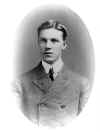 n the spring of 1908, Charley Furnas, a 28-year-old
mechanic, was working for a machinist a few blocks away from the Wright Cycle Company in
Dayton, Ohio. In his spare time, Charley did odd jobs for the Wright Brothers and pestered
them to teach him how to fly. n the spring of 1908, Charley Furnas, a 28-year-old
mechanic, was working for a machinist a few blocks away from the Wright Cycle Company in
Dayton, Ohio. In his spare time, Charley did odd jobs for the Wright Brothers and pestered
them to teach him how to fly.Wilbur
and Orville, meanwhile, were rushing to adapt their Flyer to carry two people. For years,
they had been trying to sell their invention to the U.S. Army, and their persistence had
finally paid off. The Army agreed to buy an airplane for $25,000 -- if it could
carry a pilot and a passenger. Additionally, a French syndicate of businessmen wanted to
manufacture and sell Wright planes in Europe. The brothers decided to return to
Kitty Hawk, North Carolina, where they had developed their first airplane, to test the
two-man Flyer. Kitty Hawk's steady winds would help get them airborne and its remoteness
would hide their plane from prying eyes.
Wilbur left for Kitty Hawk in early April and
found their old camp in a shambles. He was struggling to put it back to rights when --
unasked-for and unexpected -- Charley Furnas turned up. Wilbur was glad to see him, but
explained that he couldn't afford to pay him. Charley said he didn't come for the money,
he just wanted to help.
Wilbur and Charley had the camp shipshape when
Orville arrived later in the month with the Flyer. The three of them put the airplane
together and began making short hops on May 6. Occasionally, the Wrights would carry a
sandbag in the right seat to simulate the weight of a passenger. By May 14, Will and Orv
figured they were ready to try a flight with a real passenger, and they gave Charley the
honor to repay him for his work. Charley made a brief flight of 800 feet with Wilbur, then
flew for over two miles with Orville. Not only was he the first passenger ever carried on
an airplane, he was also one of the very few people to fly with both Wilbur and Orville
Wright.
Wilbur left Kitty Hawk shortly thereafter for
France. Charley went back to Dayton with Orville. Together, Orville, Charley Furnas, and
Charley Taylor -- the Wright's first mechanic -- built the first military aircraft,
shipped it to Fort Meyer, Virginia, assembled it, and helped Orville maintain and launch
it.
Charley Furnas left the Wright brothers
immediately after Orville crashed on September 17, 1908, breaking his leg and killing his
passenger. Quite possibly, the crash dissuaded Charley from his ambitions to become a
pilot. He started his own garage in his home town of West Milton, Ohio, then operated two
movie theaters. However, he remained friends with the Wrights all his life. When Charley
passed away in 1941, Orville Wright attended his funeral.
More information about Charles W. Furnas:
|
Click
on the pictures to enlarge them.

Charles W. Furnas, taken about 1900, when Charley was 20 years old. He was born
in 1880 and died in 1941.
Wilbur and Charley found the camp at Kitty Hawk almost uninhabitable in 1908.
It had been ravaged by weather and looted by visitors.

The Wright brothers adapted the 1905 Flyer 3 to carry two people, then
flew it at Kitty Hawk with Charley riding in the right seat. This is the only surviving
photo of the first two-man Flyer.

Charley Furnas witnessed the crash at Fort Meyer, Virginia, that killed Lt.
Thomas Selfridge and left Orville Wright critically injured. It's quite possible that one
of the men in the center of this photo, fighting their way through the wreckage, is
Charley.
|

